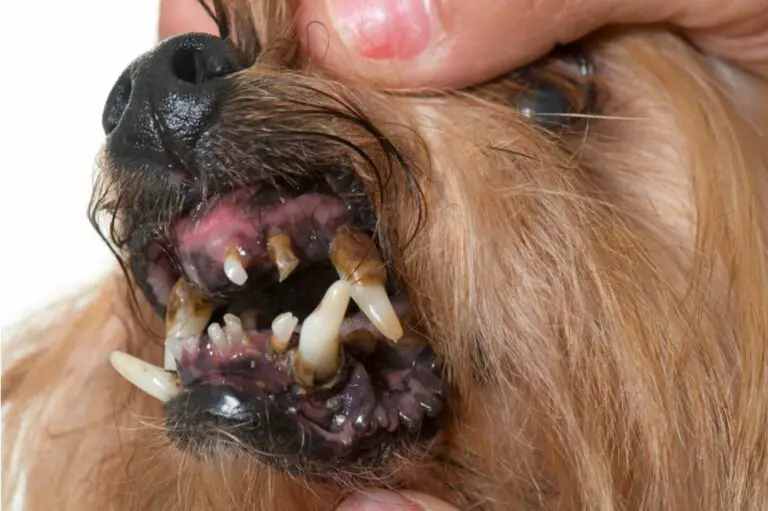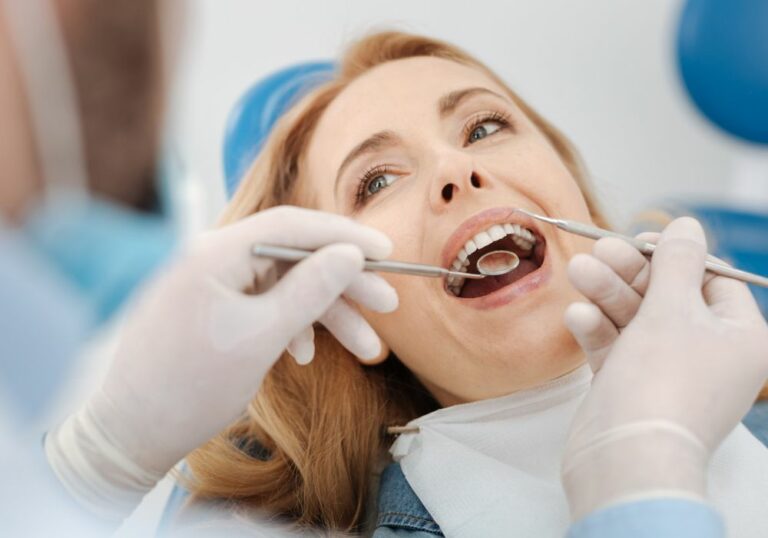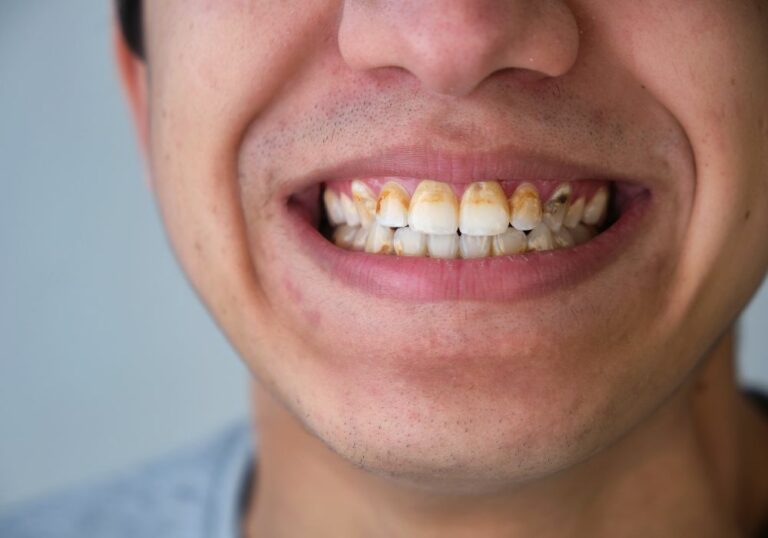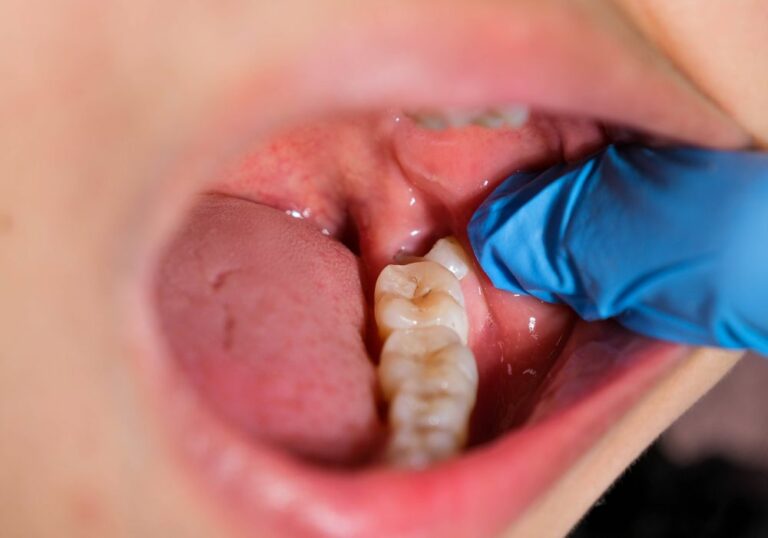Waking up to find your pearly white teeth now appear an unsightly brownish color can be upsetting. Teeth turning brown seemingly overnight often makes people worry there is something seriously wrong with their dental health. However, while sudden tooth discoloration may appear dramatic, it is rarely an emergency dental situation. In most cases, gradual staining over time is finally becoming visible enough for you to notice. There are many reasons teeth may darken from exposure to common foods, drinks, medications, tobacco, and even just aging. With some diligent dental care and treatment, you can return your teeth to their natural bright color.
What Causes Brown Staining on Teeth?
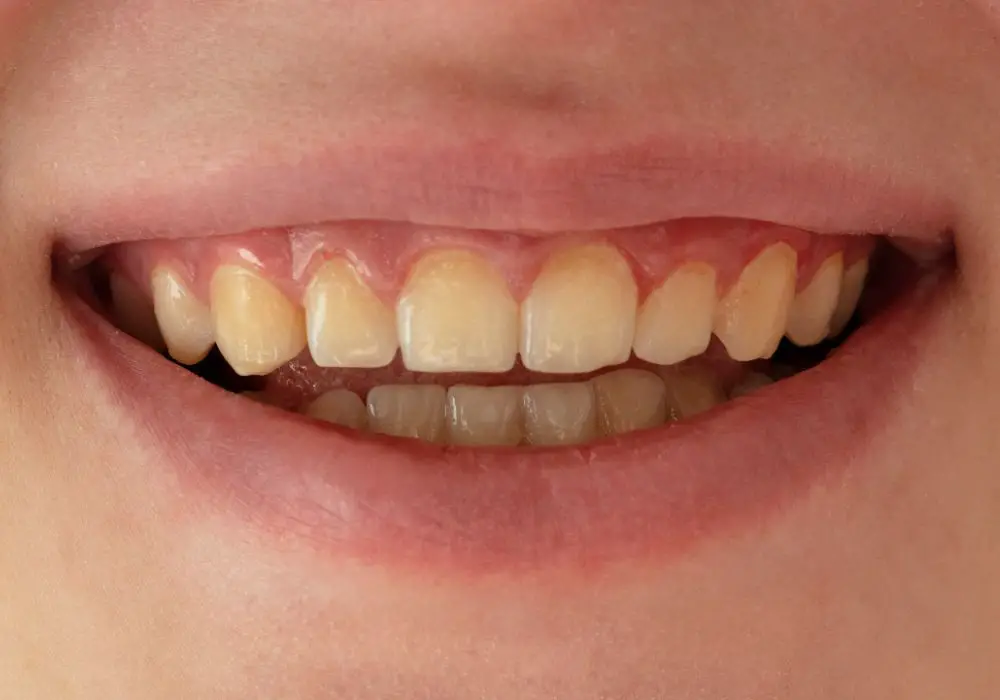
Many different factors can interact and lead to the discoloration of your tooth enamel. The components that influence staining include:
External Staining Agents
Pigmented foods, drinks, tobacco, and medicines deposited onto the surface of your teeth can penetrate into microscopic crevices in the enamel and dentin. Consuming them frequently allows stains to accumulate over time until they impact overall tooth color.
Poor Oral Hygiene
Insufficient brushing and flossing leads to plaque buildup on your teeth. The bacteria in plaque produce pigments as they multiply that seep into enamel pores. Calcified plaque known as tartar also absorbs stains from food residues on the teeth.
Enamel Composition
The density, thickness, and smoothness of tooth enamel influences how easily stains can permeate the surface. Enamel becomes more porous as you age, hence youthful teeth stay whiter longer. Enamel loss from acidic erosion or abrasion also opens the door for deep staining.
Excessive Fluoride
While important for dental health in normal amounts, excessive fluoride intake during childhood enamel development can cause mottling of tooth color with white, yellow, or brown spots.
Dentin Composition
Dentin is naturally a yellowish color underneath the enamel layer of teeth. As enamel thins with age, acidic erosion, or root resorption, the darker dentin shows through more causing a brownish tint. Exposed dentin tubules readily absorb stains.
Saliva Flow
Saliva helps rinse staining agents from your mouth before they can adhere to teeth. Dry mouth conditions reduce this natural cleansing effect allowing more accumulation of stain-producing bacteria and pigments.
Now let’s examine some of the most common causes of brown tooth discoloration in more detail.
Dietary Causes of Brown Teeth
Many foods and beverages we consume daily can contribute to a gradual darkening of your smile over time. Some of the most notorious tooth-staining offenders include:
Coffee and Tea
The richly colored compounds called tannins that give coffee and tea their distinctive taste also readily stain teeth. Sipping these popular beverages daily allows tannins to seep into microscopic cracks and etchings in your enamel. Even milk and sugar added to coffee can’t inhibit the staining effect.
Wine and Colas
Red wine is doubly damaging as its deep pigment combines with the acidity to erode enamel and enable staining. The acids in soda drinks have a similar effect. Swishing with water after consuming wine or cola can help prevent some of the staining.
Berries and Tomatoes
The vibrant anthocyanins that give berries their antioxidant power and tomatoes their rich red color will also stain your enamel if you enjoy them often. Acids in tomatoes also contribute to erosion. Choose spinach, kale or pesticide-free carrots for whiter alternatives.
Curries and Soy Sauce
The colorful spices turmeric and curry contain the compound curcumin that penetrates deep into enamel cracks. Long simmering and the salt in soy sauce draw more stain-enabling moisture out of your enamel.
Balsamic and Red Wine Vinegar
All vinegars are acidic but darker vinegars like balsamic and red wine also contain pigments that impart stain. Brighten marinades and dressings with lemon juice or rice vinegar instead.
Hard Candy and breath mints
Sugar is not the culprit here. The hard texture and chewing action can damage the protective enamel layer and expose the more porous dentin to stains.
Oil Pulling
While some promote oil pulling with coconut or sesame oil to improve oral health, these oils may seep into enamel cracks and turn rancid, causing yellow-brown stains. Stick to the ADA recommended oral care routine.
While simply restricting your intake of staining foods and beverages can help reduce discoloration, maintaining diligent oral hygiene is key to preventing those dietary stains from taking hold.
Poor Oral Hygiene
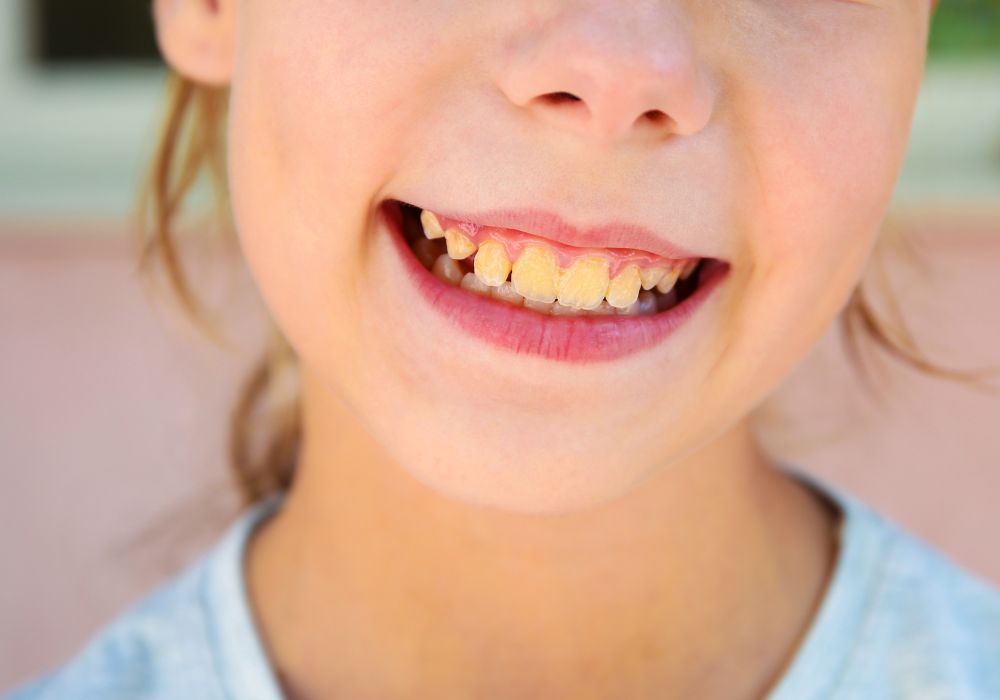
Without thorough daily plaque removal by brushing and flossing, your teeth become coated in a film of bacteria. This sticky biofilm clings to your enamel and takes on stains readily. Insufficient oral care allows the following staining processes:
Plaque Pigments
The bacteria in plaque produce yellowish pigments as they metabolize and multiply. These integrate into the plaque and get trapped against your enamel to cause yellow-brown stains.
Tartar Buildup
When plaque calcifies into tartar, it provides an extremely porous surface for pigments to sink into and become nearly impossible to remove without professional scaling.
Food Debris
Trapped food particles like coffee grounds or remnant berry seeds on plaque-covered teeth invite stain absorption. Saliva can’t penetrate plaque to rinse these away.
Enhanced Bacteria Growth
Plaque provides the ideal breeding ground for more stain-causing bacteria to thrive in your mouth. This worsens enamel staining exponentially over time.
Enamel Damage
The acids from plaque bacteria erode your enamel and open tiny defects for stains to seep deep into your teeth.
To prevent plaque stains, be sure to brush for two minutes, twice daily, and floss thoroughly once per day. See your dentist for professional cleanings every 6 months.
Tobacco Use
Smoking or chewing tobacco products delivers a concentrated dose of staining compounds to your teeth:
Tobacco Smoke
Inhaled cigarette, cigar and pipe smoke saturates your teeth with nicotine and tar that permeates deep into the microscopic pits and fissures of your enamel to cause stubborn brown stains. The heat of smoke may also break down enamel.
Smokeless tobacco
Chewing tobacco, dip, snuff, and other smokeless tobacco products keep your teeth in constant contact with tobacco plant materials that impart stain. Additives like molasses worsen discoloration. The abrasion of chewing promotes more staining.
Hard to Remove Tobacco Stains
Tobacco stains often penetrate so deeply and stubbornly adhere to enamel that they cannot be removed by brushing or even professional cleaning. Whitening treatments are often needed to lift long-term tobacco stains. The sooner you quit, the less engrained the stains become.
Medications That Stain Teeth
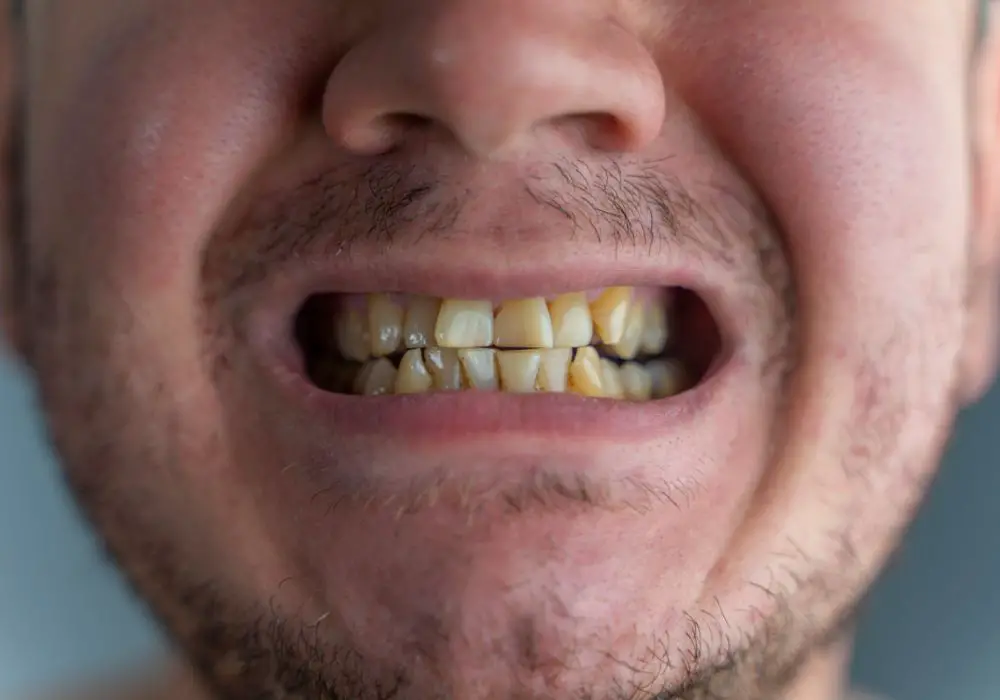
Many common prescription and over-the-counter medicines can have the unpleasant side effect of tooth discoloration.
Tetracyclines
Antibiotics in the tetracycline family are famous for causing gray, brown, or yellow staining of developing teeth in children under age 8. Adults may also be affected but less severely.
Antihistamines
Allergy, cold, and sleep medications like Benadryl contain diphenhydramine which can darken teeth of young children.
Antipsychotics
Certain psychiatric medications like chlorpromazine may deposit pigments into tooth enamel and dentin as a side effect.
Antimalarials
The widely used antimalarial drug hydroxychloroquine has a rare side effect of a blue-gray dental discoloration.
Excess Fluoride
Too much supplemental fluoride while teeth are still developing can lead to fluorosis with mottled brown and white stains.
Be sure to inform your dentist of all medications you or your child are taking to assess staining risks. Never discontinue a prescribed medication without medical advice.
Aging and Natural Tooth Color Changes
Our teeth tend to yellow slightly as we get older due to natural alterations in the composition of tooth structures:
Enamel Thinning
Enamel naturally becomes thinner over your lifetime from use, acidic erosion, and mineral loss. The thicker yellow-brown dentin underneath shows through more as you age.
Enamel Porosity
Microscopic cracks, defects, and tubules in enamel increase with age allowing deeper penetration of stains. Older enamel stains more readily.
Gum Line Recession
As gums recede they expose the yellowish root surface and make teeth appear darker overall.
Dentin Thickening
The inner dentin layer grows thicker as you age and gets yellower due to accumulation of larger dentin tubules.
Less Saliva
Reduced saliva flow as you age provides less rinsing action to clear away staining debris.
While you can’t stop the aging process, you can slow natural tooth color changes by diligently limiting other staining factors through your lifetime.
How to Prevent Teeth From Turning Brown
Fortunately, there are many ways you can defend your enamel from the assault of stain inducing foods and habits:
- Brush and floss thoroughly – Plaque is the gateway for most stains. Disrupt it daily.
- Use whitening toothpaste – Choose a brand with gentle polishing agents to lift surface stains without abrasion.
- Rinse your mouth – Swish water after eating and drinking to rinse away debris. Finish meals with crisp fruits or crunchy vegetables to naturally scrub your teeth.
- Avoid smoking and chewing tobacco – Tobacco stains often require professional whitening treatments to reverse once they set in.
- Drink stain culprits through a straw – A straw helps liquids bypass some of your tooth surfaces.
- Limit acidic and pigmented foods – Especially if consuming them frequently and without brushing after. Save for special occasions.
- Stay hydrated – Drink plenty of water to promote saliva flow for natural cleansing.
- Get regular dental cleanings – Professional removal of plaque and tartar prevents buildup of staining deposits between your own brushing and flossing.
- Use sealants – Protective coatings on pitted surfaces and grooves resist stains settling into vulnerable areas of your enamel.
- Protect against enamel erosion – Avoid excessive abrasion and acid damage to keep your enamel strong and stain resistant.
- See your dentist at first sign of discoloration – Nip stains in the bud before they become engrained.
With diligence, you can keep your teeth looking their whitest well into old age. But if stains do develop, today’s dentistry offers many effective options to reverse brown teeth and revive your naturally bright smile.
Professional Teeth Whitening Treatments
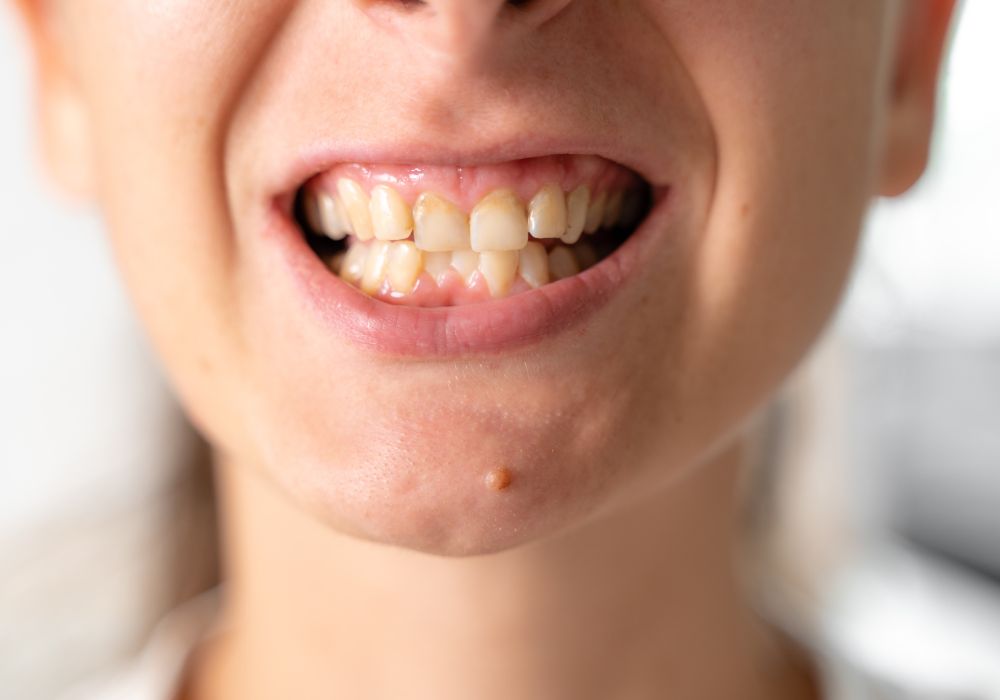
If your teeth havealready darkened from long-term exposure to staining factors, several dental treatments are available to remove brown stains and lighten your smile:
In-Office Whitening
Your dentist applies a high-concentration peroxide gel to your teeth and uses a special curing light or laser to accelerate the chemical bleaching process. Dramatic results in just one 30-60 min office visit.
Custom Take-Home Whitening Trays
Your dentist takes impressions of your teeth and provides custom-fitted whitening trays to wear a few hours per day with prescription strength whitening gel for gradual results over 1-2 weeks.
Over-the-Counter Whitening Strips or Gels
Applied by you at home using lower strength whiteners purchased at your pharmacy or grocery store. Must use consistently for 1-2 weeks. More subtle lightening than professional options.
Air Abrasion Teeth Cleaning
The dentist removes superficial stains by spraying a fine powder abrasive onto your teeth with pressurized air. Gentler than conventional scraping instruments.
Bonding or Veneers
For isolated stains or discoloration limited to one part of a tooth, bonding or veneer covers can mask the flaw with a freshly colored surface.
For optimal whitening results, avoid highly pigmented foods and tobacco for a few days after intensive professional whitening. Then maintain your bright smile by diligently brushing and flossing after meals and getting repeat professional whitening or touch up treatments as needed. With the wide selection of modern dental whitening procedures, you can successfully remove or cover even severe brown stains.
Conclusion
Don’t panic if you gaze in the mirror and are alarmed to see your formerly pearly whites now appear an unsightly shade of brown. While dramatic in appearance, sudden brown tooth discoloration is rarely an emergency. Instead, it is most often due to gradual buildup of common staining factors that finally become visible. The causes of brown stains range from daily enjoyment of pigmented foods and drinks to medications, tobacco, inadequate oral hygiene, and simply growing older. Minimizing controllable causes, improving your dental care routine, and taking advantage of professional whitening treatments can restore your teeth to their natural bright color. With vigilance, even severe long-term stains can usually be lightened. So don’t hide your smile out of embarrassment over brown teeth. See your dentist promptly to begin the tooth whitening process.

